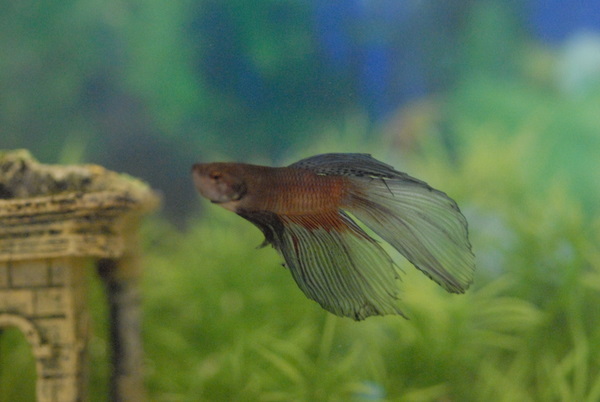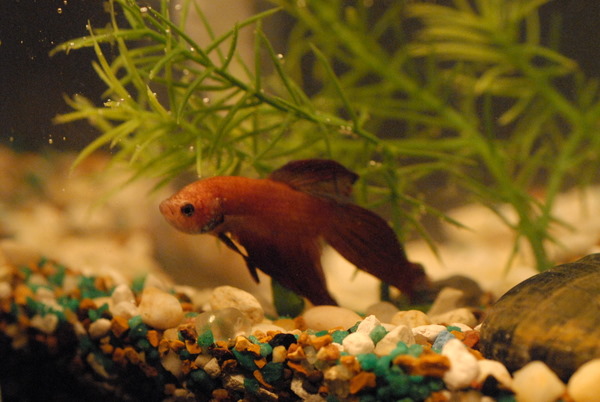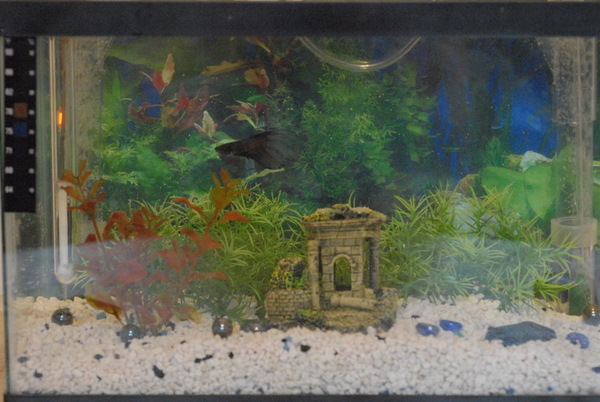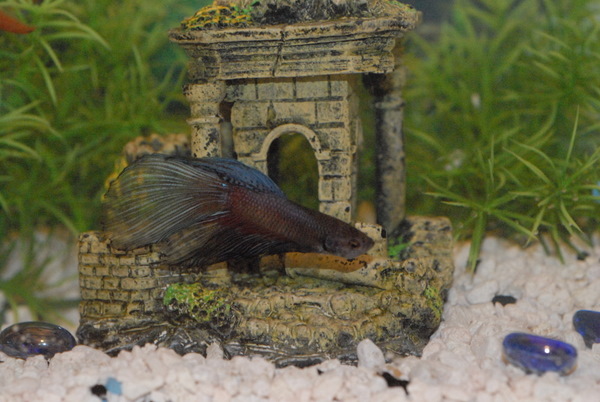|
|
Betta Behavior and Husbandry:
Linking Betta splendens Aggression with Community Tank Preservation
|
By Lonnie Lindberg |
Bright colors, elegant finnage, and a feisty attitude to boot….these
are the traits that have attracted young and old alike to the remarkable
world of the Betta fish.
Known as the Siamese fighting fish, the domesticated betta (Betta
splendens) began in the rice paddies of Thailand. There are over a
dozen wild known betta fish species living in the world today, with most
being found in southern Malaysia and nearby Indonesia. In these tropical
waters, the wild betta fish is a far cry from the gorgeous domestic
strain. They lack the vibrant colors and the gorgeous trademark fins.
Domesticated male betta fish come in a variety of colors and fin types.
There are twelve fin styles in all, but the most common types are the
veil tail, crown tail, delta, super delta, and half moon. Females tend
to be not as popular as the males due to the lack of the graceful fins.
However, they too come in a collection of eye-catching colors that can
rival any male.
What is common between the wild male betta and the male Betta
splendens is that both are known to display extremely aggressive
behavior between fellow males and unwilling females. I have also
witnessed extreme aggression from female betta fish, as well. Therefore
it is important to know and understand the factors that can trigger the
fighting instincts in the Betta splendens, especially within
the males of the species.
Researching Male Betta splendens Aggression
In college I conducted two experiments on male betta fish behavior. All
test subjects were kept separate and no animals were harmed during the
course of the experiment. All of the bettas were kept in 10 gallon (37.5
litre) tanks during both tests. As is necessary for bettas, the water
temperature was kept between 79-80 degrees Fahrenheit (26-27 degrees
Celsius). Just as with humans, they require a healthy and variable diet
full of fiber. Since these are carnivorous fish, I provided a diet of
brine shrimp and freeze dried bloodworms. Before feeding, I recommend
gut loading the brine shrimp. Crush up some flake fish food and wait
about half an hour for the shrimp to ingest the flakes. Daphnia, blood
worms, and brine shrimp are an inexpensive and necessary component of
your betta’s life. To avoid overfeeding, I recommend feeding betta fish
once every three days.
Experiment 1
For my first experiment, I hypothesized that male Betta splendens
only attack males of the same species. To avoid distraction, all the
tanks were kept bare of any substrate or furnishings. I was quite
surprised and somewhat thrilled of the final product. I’ll spare you the
statistical results and simply say that my hypothesis was thoroughly
mistaken. Not only were there attempted attacks on fellow males and
females, but also on a male fancy guppy and a fish that looks
nothing like a Betta…a goldfish. Yes, you read correctly, a
goldfish. I honestly wasn’t that surprised about the attacks on the
guppy as male fancy guppies tend to resemble the physical
characteristics of bettas. Yet a goldfish that looks nothing like a
betta and is larger in stature still provoked aggression.
Experiment 2
My second experiment was presented at the 28th Annual Western
Pennsylvania Research Symposium at Carlow College, Pittsburgh USA. With
this one I wanted to determine if territoriality was linked to a form of
cover in the male Betta splendens. In this test I had six male
Bettas as my subjects and provided aquatic plants as the form of
shelter. I tested when two males had cover, when neither had cover, and
when only one had cover. All fish were tested against each other in
those scenarios for a total of sixty trials. I thought that having a
form of cover would indeed provoke more aggression. No, once again I was
proven incorrect. One would think that the males would fight over
luscious plants perfect for egg laying. However, males were more
aggressive without any cover at all.
What Does This Mean For Betta Community Tanks?
My research revealed that there can be multiple contributing factors in
betta fish aggression. Therefore it is important to know and understand
the dynamics that can trigger the fighting instincts in the Betta
splendens, especially within the males of the species. One such
factor is age. In my report I noted that my older males were more
interested in foraging around on the gravel floor than in fighting. The
average pet store betta is already quite mature upon arrival. Unless
you’re buying from a betta breeder who knows the lineage and age of all
of his stock, there’s no way of knowing the “personality”. The variety
of betta also seems to play a role. For example, the Crown Tails seemed
more willing to engage in combat and appeared to have a more energetic
display than the Veil Tails. Naturally, genetics can also contribute to
behavior; however I did not know the lineages of my test subjects.
When rearing Betta fish think about surroundings. In these tests, plants
seemed to be used mainly as a place of refuge from rival males (maybe
even from potential predators) rather than as a reproductive factor.
Only if a female was present did a male even attempt to venture out.
It’s quite possible that the energy needed for mating is too important
to dissipate during combat. It could also be that females choose males
on their nest options rather than physical prowess. Whatever the motive,
offer plenty of hiding places with preference to thick aquatic plants.
If you’re not a plant person, try aquarium safe décor with hidey holes
or even make your own out of large rocks. Offering hiding places lets
bullied fish have a place of sanctuary. This is especially important if
you have a female betta in the tank. It gives her a place of solitude
away from the physical stresses of courtship. Plus female bettas are
also known to be very territorial, so use these habitation tips for her
too. I don’t think it wise to have a male and a female betta sharing the
same tank unless you are attempting to breed. In that case, study
breeding techniques from reputable sources. Some of my references, Mr.
Bob Fenner and Mr. John H. Tullock, are two of them. I also recommend
adding a betta fish to your tank, male or female, last. That way it will
be difficult for the fish to establish a territory. Furthermore, don’t
worry about a male betta catching any of your other pets. Those fins are
for display; not for speed. It’s also less likely females will be able
to catch other fish if there are plenty of hiding places.
Now that shelters are readily available, it’s acceptable to add other
species of fish to the betta tank. Only have peaceful community fish as
tank mates and be sure they are not known for fin-nipping. The following
table presents some of the suitable and unsuitable betta companions.
Suitable |
Unsuitable |
Female Bettas (with caution) |
Male Bettas (any variety) |
Neon Tetras |
Guppies |
Cardinal Tetras |
Goldfish |
Danios |
Barbs |
Rasboras (Harlequin, Scissortail,
Red-Tail, Clown, and Pygmy) |
Cichlids (Angelfish, Oscars, Discus,
all species) |
White Cloud Minnows |
Mollies |
Glass Catfish |
Shark Catfish |
Coolie Loaches |
Crayfish |
Corydoras Catfish |
Shrimps |
Plecos |
Snails |
African Pygmy Frog |
African Clawed Frog |
Gouramis have been known to get along well with betta fish, but it’s kind
of a shot in the dark. Both fish can battle for dominance. If you want
to attempt this try the following species. Remember that gouramis tend
to grow rather large. Make sure you have enough tank space to occupy
one. Have only one gourami per tank, please.
Gouramis |
Blue Gourami |
Pearl Gourami |
Croaking Gourami |
Dwarf Gourami |
Keep in mind that the suitable afore mentioned fish are compatible for
one very important reason: They all require similar water chemistry.
Just like the betta, the appropriate mentioned fish thrive in tropical
waters. So please don’t try pairing a betta fish with a cold water
community fish. It just doesn’t work. With this in mind, you won’t have
to worry about sacrificing one species for the other. Once more offer
plenty of hiding places; preferably thick aquatic plants.
A Happy, Healthy Aquarium
My research in no way finalizes male Betta splendens behavior
or the nature of their aggression. What it does reveal is that there are
many contributing aspects to the violent conduct of the domesticated
male betta. As such, be sure to take the necessary precautions when
creating any aquatic environment. In the case of the betta fish, whether
male or female, the Betta splendens will bring color and grace
to any aquarium. Just be sure to provide a safe habitat for both betta
and fellow tank mates. After all, a safe fish aquarium is a happy one.
References
Tankmates for Bettas. Betta Fish Junkies, 2008
Fenner, Bob.
More Than Corys: The Armored Catfish of the Family Callichthyidae.
WetWebMedia.com, 2008
Betta Tail Types: A Basic Guide. Tropical Fish Forum.Net, IPS, Inc.
2008
Betta Care. TFH Publications, New Jersey, 2002.
The Guide to Owning Bettas. TFH Publications, New Jersey, 2003
Tullock, H. John. Your Happy Healthy Pet: Betta 2nd Edition.
Wiley Publishing, New Jersey, 2006.
Betta Compatibility 1,
Betta Compatibility 2. WetWebMedia.com, 2008
|
|




